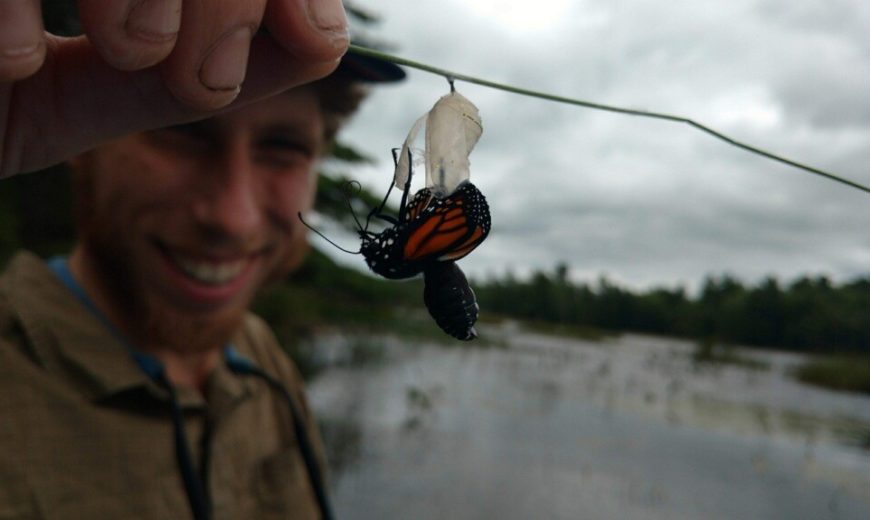Lessons from Our Native Pollinators

Article by Jason Mazurowski
It’s fall in Vermont, and change is coming. Each night is a little cooler and the all-encompassing greenness of summer is giving way to a whole new pallet of colors: the rusty tips of red maple leaves, the purples and yellows of asters and goldenrods, and an occasional, erratic flash of orange and black – like harbingers of autumn riding the wind – monarch butterflies.
This year Vermont has seen an unusual profusion of monarchs. Even walking down Church Street in Burlington, they swirl through alleyways and side streets. They dance across farm fields in the Intervale and brave the skies over whitecaps on Lake Champlain. One of the most charismatic and well-known invertebrates on the continent, monarchs seem to have emerged alongside honeybees as a symbol of the pollinator crisis.
For these creatures on the verge of the endangered species list, this summer appears to have been a bright spot of hope in an otherwise dismal outlook on pollinator health. Worldwide, insects are declining at an alarming rate, suffering from habitat loss, rampant pesticide use, disease, and phenological mismatches – all of which are expected to accelerate as climate change continues.
But this summer, my attention has been focused on another rare bright spot in the conservation world. A solution driven by the private sector, that has the potential to offset carbon emissions, preserve insect biodiversity, and generate revenue: pollinator-friendly solar development.
So rarely are we confronted with positive news pertaining to the climate crisis, that a practice promising benefits of this magnitude may illicit knee-jerk “too good to be true” reactions, and indeed, it is not without its costs. But the concept – pioneered first in the UK, and more recently gaining popularity in Minnesota – is simple enough: unused land beneath and around solar arrays can be seeded with deep-rooted, perennial vegetation, helping to control storm water runoff, reduce the need for regular mowing, and most importantly provide food and habitat for native pollinators.
In Vermont, most of our ground-based solar installations are built on former or current agricultural lands, and pollinator-friendly solar has the added benefit of attracting native bees to help with food production. Studies have shown that “prairie strips” or “pollinator gardens” planted adjacent to farm fields result in greater crop yields, and higher quality crops.
Vermont is home to over 300 species of native bees, and I’ll admit that I was unaware of their beauty and diversity until I began studying them. They come in all shapes, sizes, and colors – from bumblebee queens larger than a quarter, to tiny sweat bees the size of an ant. There are deep turquoise Ceratina, iridescent blue Osmia, and metallic green Augochlorella. Some look menacing and wasp-like, others are like tiny furry muppets, covered head to toe in pollen.
These creatures, beautiful and bizarre, can be powerful allies in our fight against climate change. There are lessons to learn from them. They fly from flower to flower, harvesting the suns energy, transformed through photosynthesis into sugar and protein. Perhaps it’s a natural fit that our own method of harnessing the sun’s energy can aid in their conservation.
Ultimately, pollinator-friendly solar serves as a model for those rare circumstances where biodiversity preservation and human development can overlap. It’s estimated that by 2030, nearly 3 million acres in the US will be occupied by ground-based solar – if pollinator habitat were installed at every site, there’s potential for millions of acres of additional habitat supporting pollinating insects. While some species, like moose or black bear need large expanses of wild land connected to surrounding populations, others – like our native bees and monarchs – can benefit from relatively small, isolated patches of native vegetation, meaning nearly anybody can help.
Burlington is a unique city. There is an unusual amount of pollinator habitat already located within our city limits – wildflowers throughout the Urban Reserve, the Intervale’s farms and gardens, and Rock Point even has its own pollinator-friendly solar project. But potential exists even within our urban centers to establish habitat in almost any “unused” space.
Take a walk through the Old North End in August, and you’ll see sunflowers and milkweed almost everywhere poking through cracks in the sidewalk, bumble bees and butterflies flitting among them. This summer, I reared 4 monarchs from caterpillars found less than 100 feet from my apartment. There are dozens of black swallowtail chrysalises preparing to overwinter on my dill and parsley, hickory tussock moth caterpillars and bumblebee queens roaming my backyard’s leaf litter.
The same principles that make pollinator-friendly solar so beneficial can be applied almost anywhere. I encourage anyone who has an unused corner of their yard to experiment, plant some native vegetation and see who comes to live there. Any scale matters, whether it’s a single sunflower, a 4×4 foot garden, or a 30-acre solar farm, if you plant it, they will come.
As with anything else in nature, the benefits will expand beyond merely providing habitat for pollinators. Deep-rooted vegetation absorbs more storm water, preventing pollutants from making their way to the lake during summer downpours. Birders will rejoice as more song birds flock to their new food source, and gardeners may see fewer pests with an influx in beneficial predatory insects. Any garden can be transformed into an ecologically functional, aesthetically pleasing habitat – a stepping stone on the long journey toward stabilizing our pollinator populations.
Not sure where to start? Here is a list of Vermont Natives that attract and support pollinators provided by the Vermont Fish and Wildlife: https://vtfishandwildlife.com/sites/fishandwildlife/files/documents/Conserve/Pollinators/Pollinator-Plant-List.pdf
Photo courtesy of: Jason Mazurowski
